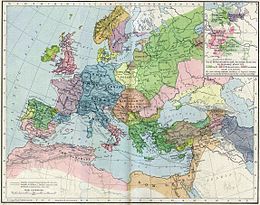
Back أتابكة أذربيجان Arabic Eldənizlər Azerbaijani ائلدنیزلر (آذربایجان آتابیگلری) AZB Илдәгизиҙәр Bashkir Ildegízida Catalan Ildegizidové Czech Atabegs von Aserbaidschan German اتابکان آذربایجان Persian Liste des atabegs d'Azerbaïdjan French Ildiguzidi Croatian
Eldiguzids Atabegs of Azerbaijan اتابکان آذربایجان | |||||||||||
|---|---|---|---|---|---|---|---|---|---|---|---|
| 1136–1225 | |||||||||||
![Territory of the Eldiguzids in 1180 CE.[1]](http://upload.wikimedia.org/wikipedia/commons/thumb/4/4b/Map_of_the_Eldiguzids_in_1180_CE.png/300px-Map_of_the_Eldiguzids_in_1180_CE.png) Territory of the Eldiguzids in 1180 CE.[1] | |||||||||||
| Status | Atabegate | ||||||||||
| Capital | Nakhchivan Hamadan Tabriz | ||||||||||
| Common languages | Persian (official, court literature)[2][3] | ||||||||||
| Atabeg | |||||||||||
• 1136–1175 | Eldiguz | ||||||||||
• 1175–1186 | Muhammad | ||||||||||
• 1186–1191 | Qizil Arslan | ||||||||||
• 1191–1210 | Nusrat al-Din Abu Bakr | ||||||||||
• 1210–1225 | Muzaffar al-Din Uzbek | ||||||||||
| History | |||||||||||
• Established | 1136 | ||||||||||
• Disestablished | 1225 | ||||||||||
| |||||||||||


The Ildegizids,[4] Eldiguzids[5][6] or Ildenizids, also known as Atabegs of Azerbaijan[7][8] (اتابکان آذربایجان Atabakan-e Āzarbayjan) were an Atabegate of the Seljuk Empire, and a Sunni Muslim Turkic[6] dynasty[9] (started by Eldiguz of Kipchak[6] origin), which controlled most of northwestern Persia,[5] eastern Transcaucasia, including[5] Arran,[5][6][8] most of Iranian Azerbaijan,[5][6][8] and Jibal.[5][6][8] At their maximum extent, the territory under their control, roughly corresponds to most of north-western Iran, most of the regions of modern Azerbaijan and smaller portions in modern Armenia (southern part), Turkey (northeastern part) and Iraq (eastern part). Down to the death in war 1194 of Toghril b. Arslan, last of the Great Seljuq rulers of Iraq and Persia, the Ildenizids ruled as theoretical subordinates of the Sultans, acknowledging this dependence on their coins almost down to the end of the Seljuqs.[5] Thereafter, they were in effect an independent dynasty, until the westward expansion of the Mongols and the Khwarazm-Shahs weakened and then brought the line to its close.[5]
Atabeg (literally means "fatherly lord" in Turkic) was the title conferred upon the Turkic officers who served as guardians of minor Seljuq rulers.[10] In the political circumstances of the time, Atabegs were not only tutors and vice-regents of their princes, but also de facto rulers.[10] At the height of Eldiguzid power, their territory stretched from Isfahan in the south to the borders of Kingdom of Georgia and Shirvan in the north. However, closer to the end of their reign amidst continuous conflicts with the Kingdom of Georgia, the Eldiguzid territory shrank to include only Azerbaijan and eastern Transcaucasia.[6]
The historical significance of the Atabeg of Azerbaijan lies in their firm control over north-western Persia during the later Seljuq period and also their role in Transcaucasia as champions of Islam against the Bagratids of Georgia.[6]
- ^ Boyle (Ed.), J. A. (1958). The Cambridge History of Iran: Volume 5: The Saljuq and Mongol Periods. Cambridge: Cambridge University Press. p. 188, Map 4. ISBN 9781139054973.
- ^ Katouzian 2007, p. 128.
- ^ de Bruijn 2019, p. 105.
- ^ Lewis, Bernard (1994). Sir Hamilton Alexander Rosskeen Gibb (ed.). Encyclopedia of Islam. Vol. 10. Brill. p. 554.
- ^ a b c d e f g h C.E. Bosworth, "Ildenizids or Eldiguzids", Encyclopaedia of Islam, Edited by P.J. Bearman, Th. Bianquis, C.E. Bosworth, E. van Donzel and W.P. Heinrichs et al., Encyclopædia of Islam, 2nd Edition., 12 vols. with indexes, etc., Leiden: E. J. Brill, 1960–2005. Vol 3. pp 1110-111. Excerpt 1: "Ildenizids or Eldiguzids, a line of Atabegs of Turkish slave commanders who governed most of northwestern Persia, including Arran, most of Azarbaijan, and Djibal, during the second half of the 6th/12th century and the early decades of the 7th/13th century". Excerpt 2: "The Turkish Ildenizids shared to the full in the Perso-Islamic civilization"
- ^ a b c d e f g h Bosworth, Clifford Edmund (1996). The New Islamic Dynasties: A Chronological and Genealogical Manual. Columbia University Press. pp. 199–200. ISBN 0-231-10714-5.
pp 199-200(Eldiguizds or Ildegizds): "The Elgiguzids or Ildegizds were a Turkish Atabeg dynasty who controlled most of Azerbaijan(apart from the region of Maragha held by another Atabeg line, the Ahamadilis), Arran and northern Jibal during the second half the twelfth century when the Great Seljuq Sultane of Western Persia and Iraq was in full decay and unable to prevent the growth of virtually independent powers in the province", pp 199-200: "Eldiguz (Arabic-Persian sources write 'y.l.d.k.z) was originally a Qipchaq military slave", pp199-200: "The historical significance of these Atabegs thus lies in their firm control over most of north-western Persia during the later Seljuq period and also their role in Transcaucasia as champions of Islamagainst the resurgent Bagtarid Kings". pp 199: "In their last phase, the Eldiguzids were once more local rulers in Azerbaijan and eastern Transcaucasia, hard pressed by the aggressive Georgians, and they did not survive the troubled decades of the thirteenth century".
- ^ Hodgson, Marshall G.S. (1977). The expansion of Islam in the middle periods Volume 1. University of Chicago Press. p. 262. ISBN 0-226-34684-6.
- ^ a b c d Luther, K.A. (December 15, 1987). "Atabakan-e Ādarbayjan". Encyclopedia Iranica. Retrieved October 28, 2010.
- ^ Britannica. Article: Eldegüzid dynasty:
Eldegüzid dynasty, also spelled Ildigüzid, Ildegüzid, Ildegizid, or Ildenizid, (1137–1225), Iranian atabeg dynasty of Turkish origin that ruled in Azerbaijan and Arrān (areas now in Iran and Azerbaijan).
- ^ a b Hodgson, Marshall G.S. The Venture of Islam: Conscience and History in a World Civilization, University of Chicago Press, 1974, ISBN 0-226-47693-6, p. 260